View in other NatureServe Network Field Guides
NatureServe
Montana
Utah
Wyoming
Idaho
Wisconsin
British Columbia
South Carolina
Yukon
California
New York
Giant Salmonfly - Pteronarcys californica
General Description
This is the famous Salmonfly, and is the largest species of all mayflies, stoneflies or caddisflies hatching on any western river, up to 3 inches long. In late-May to early July, adults are hatching and providing trout fisherman with exciting dry-fly fishing on the surface or underwater with large artificial nymphs. Adults are fairly weak fliers and are very conspicuous by their size and erratic flight over the river making them easy pickings for feeding trout or insectivrous birds. The Giant Salmonfly range in Montana only overlaps with one other potentially confusing species; the American Salmonfly, Pteronarcys dorsata which has been reported to occur in the Smith and Missouri River basins. For an in depth report on the assessment of this species in Montana go online:
http://mtnhp.org/reports/ZOO_MT_Salmonfly_2010.pdfPhenology
In late-May to early July, nymphs are crawling out of the water to the adjacent riparian vegetations and the adults are hatching out. June is usually prime emergence time, but can emerge much earlier (late-April) in warmer streams (Rockwell and Newell 2009).
Diagnostic Characteristics
Salmonflies are easy to identify mostly by their tremendous size; these stoneflies (Order Plecoptera: Family Pteronarcyidae) often measure nearly three inches in length. As adults, they have a bright orange or red band behind the head and the underside of abdomen with broad wings containing dark veins
Species Range
Montana Range
Range Descriptions
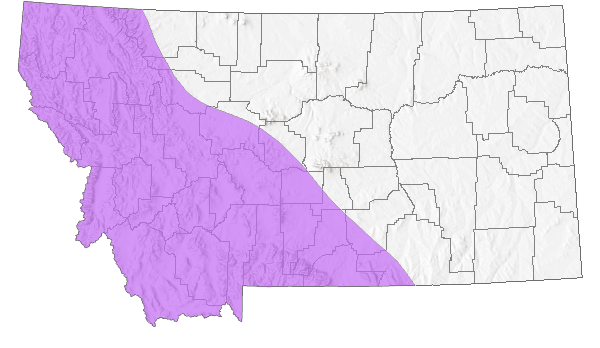
 Native
Native
Range Comments
Range includes the Coast, Cascade, Rocky, and Sierra Nevada Mountains northward to Alaska and Yukon and southward to Mexico. It is found throughout the northern and eastern Basin and Range province of the western U.S. but absent in the western Great Basin (Baumann et al., 1977; Sheldon, 1979; Stark et al., 1998; Stewart and Oswood, 2006; Stewart and Stark, 2002).
Observations in Montana Natural Heritage Program Database
Number of Observations: 116
(Click on the following maps and charts to see full sized version)
Map Help and Descriptions
Relative Density
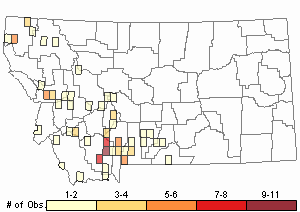
Recency
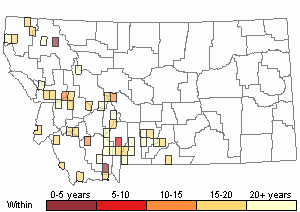
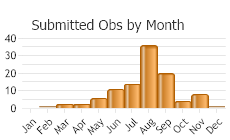
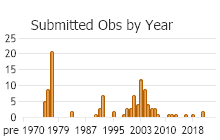
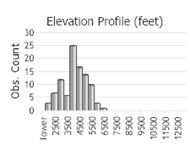 (Observations spanning multiple months or years are excluded from time charts)
(Observations spanning multiple months or years are excluded from time charts)
Migration
This species is not known to make migration flights, but generally flies in an upstream direction.
Habitat
Salmonfly nymphs live on the bottom, crawling around on cobbles and feeding on large organic materials (leaves) in the spaces between rocks for three to sometimes four years. They require well-oxygenated water, so they thrive in swift, bouldery, riffly stretches of the river; narrow canyon reaches such as Yankee Jim Canyon of the Yellowstone, Alberton Gorge of the Clark Fork River, Big Hole Canyon between Glen and Wise River or Bear Trap Canyon of the Madison are ideal habitat.
Food Habits
Pteronarcys nymphs generally are considered shredders as a functional feeding group, and feed on large particular organic and leaf materials that have collected in debris dams or behind boulders or logjams.
Ecology
Pteronarcys nymphs grow through many instars (12 - 20). The length of the life cycle is 3 to 4 years depending on elevation and degree days (water, temperature and air)(Baumann et al. 1977). Mature nymphs migrate to shore in the spring and climb out of the water (mostly at night) before the final molt. Adults live for a few days to few weeks among shoreline vegetation or rocks and they feed little, if at all. Males attract mates by drumming rocks or wood, and mate while on the wing. Females lay the eggs on or above the water. The eggs separate and sink to the bottom to begin the next generation. Multiple cohorts may exist in any given river allowing a salmonfly hatch to occur every year, but some cohorts are stronger than others.
Stewardship Responsibility
Threats or Limiting Factors
The biggest threats to the salmonfly are attributable to the loss of habitat through siltation, sediment filling interstitial spaces in the cobbles or increasing water temperatures beyond the species thermal limits.
References
- Literature Cited AboveLegend:
 View Online Publication
View Online Publication Baumann, R.W, A.R. Gaufin, and R.F. Surdick. 1977. The stoneflies (Plecoptera) of the Rocky Mountains. American Entomological Society, Philadelphia.
Baumann, R.W, A.R. Gaufin, and R.F. Surdick. 1977. The stoneflies (Plecoptera) of the Rocky Mountains. American Entomological Society, Philadelphia. Rockwell, I.P. and R.L. Newell. 2009. Note on mortality of the emerging stonefly (Pteronarcys californica) on the Jocko River, Montana, USA. Western North American Naturalist. 69:264-266
Rockwell, I.P. and R.L. Newell. 2009. Note on mortality of the emerging stonefly (Pteronarcys californica) on the Jocko River, Montana, USA. Western North American Naturalist. 69:264-266 Sheldon, A.L. 1979. Stonefly (Plecoptera) Records from the Basin Ranges of Nevada and Utah. The Great Basin Naturalist 39(3): 289-292.
Sheldon, A.L. 1979. Stonefly (Plecoptera) Records from the Basin Ranges of Nevada and Utah. The Great Basin Naturalist 39(3): 289-292. Stark, B.P., K.W. Stewart, S.W. Szczytko, R.W. Baumann. 1998. Common names of Stoneflies (Plecoptera) from the United States and Canada. Ohio Biological Survey Notes 1: 1-18, 1998.
Stark, B.P., K.W. Stewart, S.W. Szczytko, R.W. Baumann. 1998. Common names of Stoneflies (Plecoptera) from the United States and Canada. Ohio Biological Survey Notes 1: 1-18, 1998. Stewart, K.W. and B.P. Stark. 2002. Review and further descriptions of eggs of females of North American stonefly genus Setvena (Plecoptera: Perlodidae). Entomological News, 113(2): 97-93.
Stewart, K.W. and B.P. Stark. 2002. Review and further descriptions of eggs of females of North American stonefly genus Setvena (Plecoptera: Perlodidae). Entomological News, 113(2): 97-93.
- Additional ReferencesLegend:
 View Online Publication
View Online Publication
Do you know of a citation we're missing? Anderson, H.E. 2018. Environmental drivers of salmonfly ecology in southwest Montana. M.Sc. Thesis. Bozeman, MT: Montana State University. 72 p.
Anderson, H.E. 2018. Environmental drivers of salmonfly ecology in southwest Montana. M.Sc. Thesis. Bozeman, MT: Montana State University. 72 p. Anderson, H.E., L.K. Albertson, and D.M. Walters. 2019. Thermal variability drives synchronicity of an aquatic insect resource pulse. Ecosphere 10(8):e02852.
Anderson, H.E., L.K. Albertson, and D.M. Walters. 2019. Thermal variability drives synchronicity of an aquatic insect resource pulse. Ecosphere 10(8):e02852. Baril, S.F. 1977. Benthic invertebrate distribution, abundance, and diversity in Rosebud Creek, Montana. M.Sc. Thesis. Bozeman, MT: Montana State University. 97 p.
Baril, S.F. 1977. Benthic invertebrate distribution, abundance, and diversity in Rosebud Creek, Montana. M.Sc. Thesis. Bozeman, MT: Montana State University. 97 p. Burns, D.C. 1973. Plecoptera of the West Fork of the West Gallatin River and factors influencing their distribution. M.Sc. Thesis. Bozeman, Montana: Montana State University. 71 p.
Burns, D.C. 1973. Plecoptera of the West Fork of the West Gallatin River and factors influencing their distribution. M.Sc. Thesis. Bozeman, Montana: Montana State University. 71 p. Fraley, J.J. 1978. Effects of elevated summer water temperatures below Ennis Reservoir on the microinvertebrates of the Madison River, Montana. M.Sc. Thesis. Bozeman, MT: Montana State University. 120 p.
Fraley, J.J. 1978. Effects of elevated summer water temperatures below Ennis Reservoir on the microinvertebrates of the Madison River, Montana. M.Sc. Thesis. Bozeman, MT: Montana State University. 120 p. Garrett, P.A. 1973. The distribution and abundance of aquatic insects in the Middle West Gallatin drainage. M.Sc. Thesis. Bozeman, Montana: Montana State University. 60 p.
Garrett, P.A. 1973. The distribution and abundance of aquatic insects in the Middle West Gallatin drainage. M.Sc. Thesis. Bozeman, Montana: Montana State University. 60 p. Gustafson, D. L. 1990. Ecology of aquatic insects in the Gallatin River drainage. Ph.D. Dissertation. Bozeman, MT: Montana State University. 194 p.
Gustafson, D. L. 1990. Ecology of aquatic insects in the Gallatin River drainage. Ph.D. Dissertation. Bozeman, MT: Montana State University. 194 p. Heaton, J.R. 1966. The benthos and drift fauna of a riffle in the Madison River, Yellowstone National Park. Ph.D. Dissertation. Bozeman, Montana: Montana State University. 59 p.
Heaton, J.R. 1966. The benthos and drift fauna of a riffle in the Madison River, Yellowstone National Park. Ph.D. Dissertation. Bozeman, Montana: Montana State University. 59 p. Stadnyk, L. 1971. Factors affecting the distribution of Stoneflies in the Yellowstone River, Montana. M.Sc. Thesis. Bozeman, Montana: Montana State University. 36 p.
Stadnyk, L. 1971. Factors affecting the distribution of Stoneflies in the Yellowstone River, Montana. M.Sc. Thesis. Bozeman, Montana: Montana State University. 36 p. Vincent, E.R. 1966. A comparison of riffle insect populations in the Gibbon River above and below the geyser basins, Yellowstone National Park. M.Sc. Thesis. Bozeman, MT: Montana State University. 19 p.
Vincent, E.R. 1966. A comparison of riffle insect populations in the Gibbon River above and below the geyser basins, Yellowstone National Park. M.Sc. Thesis. Bozeman, MT: Montana State University. 19 p.
- Web Search Engines for Articles on "Giant Salmonfly"
- Additional Sources of Information Related to "Insects"





